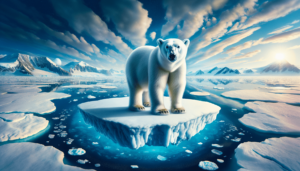Global Warming: An Alarming Reality
The causes of global warming have moved from the realm of scholarly debates to the forefront of global concerns. This undeniable reality isn’t just an academic topic anymore. Our world is rapidly changing: coastlines recede, weather patterns shift, and species face threats. What’s behind these dramatic changes?
The Greenhouse Effect: The Main Instigator
The primary cause of global warming is the greenhouse effect. Picture yourself in a car on a sunny day with windows shut. Comfort turns to discomfort as the interior heats up. This is the greenhouse effect on a smaller scale.
Earth’s atmosphere acts similarly. Sunlight warms our ground, and while most of this warmth should reflect back into space, greenhouse gases trap a significant portion. These gases, in the right amounts, make Earth hospitable. But in excess, they intensify warming. Activities like burning fossil fuels, deforestation, and industrial processes exacerbate the causes of global warming by boosting these gas levels.
Solutions: Our Way Forward
To counteract the causes of global warming, we must turn to solutions. Renewable energy, sustainable agriculture, and afforestation are potential paths forward. With the right mix of technology and policy, a more sustainable future becomes possible.
Causes of Global Warming: The Role of Human Activities
Industrial Processes and Energy Production
One of the principal causes of global warming stems from our industrial processes and energy production methodologies. As societies pursued rapid growth and technological progress, we unwittingly anchored our industries on the burning of fossil fuels – namely coal, oil, and natural gas. These fuels, when burned, emit copious amounts of carbon dioxide (CO2) and other greenhouse gases. It’s as if humanity took a deep dive into carbon indulgence, and now, we are grappling with its climatic repercussions.
Currently, nearly two-thirds of global electricity generation sources from fossil fuels. This dependence marks it as the predominant contributor to global greenhouse gas emissions. The very energy that powers our homes, drives our industries, and propels our modern civilization also casts a long, dark shadow on our environment.
Deforestation
Forests play an invaluable role in the fight against global warming. Beyond providing biodiversity and natural habitats, trees function as indispensable carbon sinks, drawing CO2 from the atmosphere. However, our escalating demands for agricultural expansion, timber, and urban spaces have instigated rampant deforestation. This not only strips the Earth of its natural CO2 absorbers but also releases previously sequestered carbon.
When forests face the axe or the torch, the carbon stored within them is reintroduced into the atmosphere. This cycle not only bolsters the levels of atmospheric CO2 but also diminishes our planet’s inherent ability to mitigate these increases.
Agriculture and Land Use Changes
The intricate web of agriculture has its own set of challenges when it comes to global warming. Processes like rice cultivation and the natural digestion of cattle emit methane. Alarmingly, methane is over 25 times more effective at trapping heat than CO2 over a century-long period. In addition, certain agricultural techniques and shifts in land usage lead to nitrous oxide emissions, another potent contributor to the greenhouse effect.
Land transformations, especially when forests are cleared for farming, further amplify CO2 releases. Our global food infrastructure, spanning from cultivation to delivery, accounts for nearly a third of all anthropogenic greenhouse gas emissions.
Waste Generation and Disposal
Our habits of consumption and disposal are intricately linked to global warming. When organic waste gets dumped into landfills, it undergoes anaerobic decomposition, generating methane in the process. Those seemingly innocuous food scraps and overlooked perishables in our refrigerators inadvertently exacerbate the causes of global warming once they’re relegated to landfills. Enhancing waste management practices and promoting recycling and composting can be pivotal in addressing this issue.
Causes of Global Warming: The Consequences
Climate Shifts
The causes of global warming extend their impact far beyond mere temperature escalation. They precipitate a complete transformation of the intricate climatic patterns foundational to life.
With the atmosphere retaining more heat, there’s increased evaporation, which in turn reshapes rainfall patterns. Regions like Germany and Belgium, for instance, were subjected to alarming floods in 2021, a calamity closely tied to these evolving patterns. Conversely, areas like California bear witness to prolonged dry spells, exemplified by its near-decade-long drought. Such erratic rainfall behaviors jeopardize agriculture, potentially leading to food shortages and compromising our water resources.
Extreme Weather Patterns
The ripple effects of global warming encompass an augmentation of extreme weather events. The additional warmth stored in the atmosphere and oceans amplifies the potency of storms, exacerbates heatwaves, and even escalates cold weather phenomena.
A case in point was the 2021 Texas winter storm—a tragic episode emphasizing that the causes of global warming can magnify even cold-weather patterns. Meanwhile, the unprecedented heatwaves striking Canada and the Pacific Northwest served as a testament to the devastatingly hot extremes. These intensified weather occurrences strain not only human resilience but also our infrastructure and emergency response systems.
Ecological Impact
However, the consequences of global warming are not limited to human arenas; they extend their grip to the ecological tapestries that form Earth’s biological framework. Changing climatic patterns create a chain reaction, unsettling the equilibrium among flora and fauna.
For instance, warmer climes modify the schedules of natural phenomena such as blooming and avian migrations. Observations show some bird species embarking on their migratory journeys earlier, misaligning with food availability and potentially jeopardizing their survival.
Such ecological alterations could upset entire food webs, placing both specific species and overarching ecosystems in peril.
Biodiversity Loss
Arguably, one of the most profound ramifications of global warming is the erosion of Earth’s biodiversity. The current rate of species loss, accelerated by the causes of global warming, mirrors the mass extinctions of yore. As vital habitats—like ice caps, coral sanctuaries, and mountain grasslands—recede or transform due to the warming trend, myriad species edge closer to extinction.
Polar bears, for instance, are emblematic of this crisis. As the Arctic ice retreats, these majestic creatures grapple with dwindling hunting terrains. Coral ecosystems, which house a vast array of marine biodiversity, confront extensive bleaching episodes due to warmer sea temperatures.
This biodiversity attrition jeopardizes not merely the aesthetic splendor of nature, but also the essential ecosystem services on which humanity relies—spanning from pollination and water cleansing to atmospheric balance.
The Mitigating Causes of Global Warming: What Can We Do?
Switching to Renewable Energy
One of the most potent remedies to counter the causes of global warming lies in our energy choices. Fossil fuels, with their high carbon emissions, have long been a significant contributor. Shifting our reliance to renewable energy sources offers hope. Solar, wind, hydro, and geothermal energy are not only sustainable but also result in significantly reduced carbon footprints.
In the context of this shift, technological strides are propelling renewables to the forefront. Their increased efficiency and reduced costs make them more accessible and practical. Nations like Denmark, Costa Rica, and Germany are living proof of a successful transition towards renewables. Additionally, the proliferation of enterprises promoting home solar installations shows that solutions to global warming can be as localized as our own rooftops.
Afforestation and Reforestation
Trees stand as Earth’s natural carbon absorbers, playing a pivotal role in mitigating the causes of global warming. By ramping up efforts in afforestation (planting trees where none were before) and reforestation (replanting trees where forests were cleared), we can actively sequester more carbon dioxide.
But the benefits don’t halt at carbon absorption. Forests play multifaceted roles. They fortify soils against erosion, modulate water cycles, and create habitats, thereby bolstering biodiversity. Global endeavors, such as the Bonn Challenge and the Trillion Tree Campaign, reflect a rising collective consciousness about the value of forests in the fight against global warming.
Sustainable Agriculture and Waste Management
Reimagining agriculture through a sustainable lens can dramatically attenuate its contribution to global warming. By integrating methods like precision agriculture (using technology to enhance crop yields and sustainability), organic farming (eschewing synthetic fertilizers and pesticides), and agroforestry (melding agriculture and forestry), we can cut down on emissions and foster more resilient ecosystems.
Furthermore, addressing waste can be a formidable strategy against global warming. Composting, for instance, turns organic waste into nutrient-rich soil enhancers, sidelining methane production. Recycling not only curbs the demand for new raw materials but also reduces the energy expended in production processes. By embracing these practices and fostering a culture of reduced waste, we can significantly diminish our ecological footprint and counteract the causes of global warming.
The Future: A World Unchecked by Global Warming
If global warming continues unchecked, the Earth’s future is bleak. The potential repercussions stretch from rising sea levels that could inundate coastal cities to devastating droughts and food shortages. The rich tapestry of biodiversity we’re familiar with may face unparalleled extinction rates. The socio-economic consequences, such as forced migrations due to uninhabitable zones, could lead to geopolitical tensions, further destabilizing our world. This potential reality is not intended to incite fear but to underline the necessity of immediate action. [This section would fit well right before the “Conclusion” part for greater emphasis on the urgency of the matter.]
Taking proactive steps towards alleviating global warming is not a choice but an imperative. Shifting towards renewable energy, championing reforestation, and embedding sustainability into our daily lives can have monumental effects. These strategies require global synergy, transcending borders, cultures, and beliefs. It’s not only about policy shifts at the governmental level but also about lifestyle changes at the grassroots.
Facing this challenge won’t be a cakewalk. It will test our resolve, innovation, and collective spirit. Yet, if there’s any species on Earth capable of reversing the damage, it’s us. The narrative isn’t about guilt, but responsibility and action.
So, as we navigate this complex journey, it’s essential to remember the broader perspective. It’s not solely about preserving Earth; it’s about safeguarding humanity’s future. One day, we want to recount tales to future generations, not of despair, but of hope, resilience, and the indomitable human spirit that rose to meet, address, and conquer the causes of global warming. This is our legacy, and this, unequivocally, is the essence of being human.
Conclusion
Global warming. Even the very mention of this phenomenon brings a sense of urgency and concern, especially among those who understand its far-reaching implications. The fact remains that this monumental challenge, which shadows our present, was largely fueled by human activities. Decades of industrialization, an unbridled race for energy, and the over-exploitation of Earth’s resources are primary contributors to this looming crisis.
Yet, it’s crucial to remain optimistic. If there’s one thing history teaches us, it’s the remarkable human capacity for innovation, resilience, and adaptability. By digging deep into the causes of global warming, we uncover not just the root of our problems but also pathways to solutions.
FAQs
What is the most significant cause of global warming? The burning of fossil fuels for electricity, heat, and transportation is the most significant cause of global warming. This accounts for the largest share of total greenhouse gas emissions, predominantly in the form of CO2. However, it’s important to note that a variety of human activities contribute to global warming, including deforestation, agriculture, and waste disposal.
What role do natural processes play in global warming? Natural processes such as volcanic eruptions, variations in solar radiation, and changes in the Earth’s orbit can influence the Earth’s climate. However, the current phase of global warming is largely attributed to human activities. The rate at which the planet’s temperature is rising far exceeds the pace of natural warming that occurred in pre-industrial times.
How do trees help combat global warming? Trees absorb CO2, a primary greenhouse gas, from the atmosphere during photosynthesis, effectively acting as carbon sinks. Furthermore, forests provide a habitat for countless species, supporting biodiversity. However, when these trees are cut down or burnt, the stored carbon is released back into the atmosphere, contributing to global warming.
Can we stop global warming? While we can’t stop global warming overnight, we can significantly slow it down by reducing greenhouse gas emissions. This includes switching to renewable energy, adopting sustainable agricultural practices, and improving waste management. It’s a global issue that requires collective action, but each one of us can contribute to the solution in our own small way.
How does renewable energy help reduce global warming? Renewable energy sources like solar, wind, and hydro don’t emit greenhouse gases when generating electricity. By switching to renewables, we can reduce our dependence on fossil fuels, which are the main source of greenhouse gas emissions. Furthermore, unlike fossil fuels, renewable energy sources are virtually inexhaustible and can provide a more sustainable solution for our energy needs.




